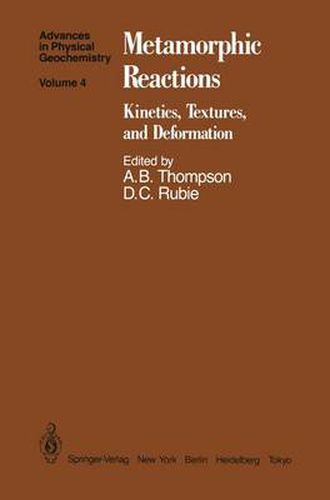Readings Newsletter
Become a Readings Member to make your shopping experience even easier.
Sign in or sign up for free!
You’re not far away from qualifying for FREE standard shipping within Australia
You’ve qualified for FREE standard shipping within Australia
The cart is loading…






This title is printed to order. This book may have been self-published. If so, we cannot guarantee the quality of the content. In the main most books will have gone through the editing process however some may not. We therefore suggest that you be aware of this before ordering this book. If in doubt check either the author or publisher’s details as we are unable to accept any returns unless they are faulty. Please contact us if you have any questions.
The fourth volume in this series consists of eleven chapters. The first five deal with more theoretical aspects of the kinetics and mechanisms of meta morphic reactions, and the next six consider the interdependence of defor mation and metamorphism. All papers deal with natural processes that inter act on various time scales and with different degrees of mass and heat transfer. Consequently, many fundamental axioms of metamorphic petrol ogy and structural geology are questioned both for their accuracy and their usefulness. In raising such questions, most contributors have pointed to ways in which the answers could be forthcoming from appropriate experi mental studies or observations on natural materials. In their discussion of how order/disorder can influence mineral assem blages, Carpenter and Putnis emphasize that metastable crystal growth is common in metamorphic systems and state’ ‘there may be some reluctance (among many earth scientists) to accept that significant departures from equilibrium could occur. On the basis of presented evidence, they question whether reactions ever occur close to an equilibrium boundary. The neces sity for pressure or temperature overstepping is also required by nucleation rate theory. In any case, the degree of order is severely influenced by these kinetic effects in igneous, sedimentary, and metamorphic environments.
$9.00 standard shipping within Australia
FREE standard shipping within Australia for orders over $100.00
Express & International shipping calculated at checkout
This title is printed to order. This book may have been self-published. If so, we cannot guarantee the quality of the content. In the main most books will have gone through the editing process however some may not. We therefore suggest that you be aware of this before ordering this book. If in doubt check either the author or publisher’s details as we are unable to accept any returns unless they are faulty. Please contact us if you have any questions.
The fourth volume in this series consists of eleven chapters. The first five deal with more theoretical aspects of the kinetics and mechanisms of meta morphic reactions, and the next six consider the interdependence of defor mation and metamorphism. All papers deal with natural processes that inter act on various time scales and with different degrees of mass and heat transfer. Consequently, many fundamental axioms of metamorphic petrol ogy and structural geology are questioned both for their accuracy and their usefulness. In raising such questions, most contributors have pointed to ways in which the answers could be forthcoming from appropriate experi mental studies or observations on natural materials. In their discussion of how order/disorder can influence mineral assem blages, Carpenter and Putnis emphasize that metastable crystal growth is common in metamorphic systems and state’ ‘there may be some reluctance (among many earth scientists) to accept that significant departures from equilibrium could occur. On the basis of presented evidence, they question whether reactions ever occur close to an equilibrium boundary. The neces sity for pressure or temperature overstepping is also required by nucleation rate theory. In any case, the degree of order is severely influenced by these kinetic effects in igneous, sedimentary, and metamorphic environments.